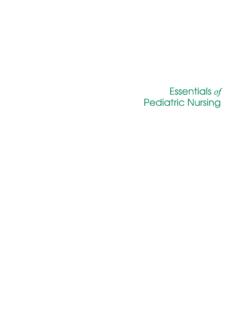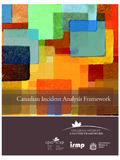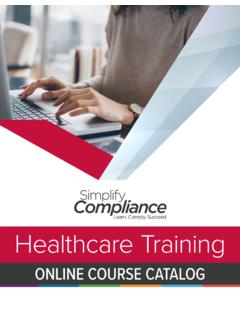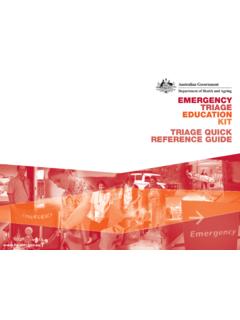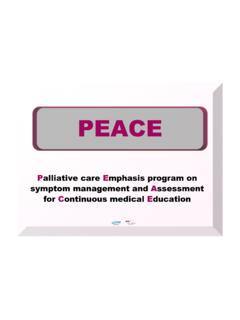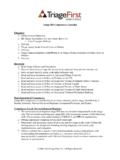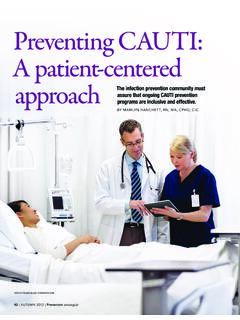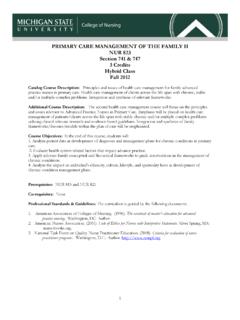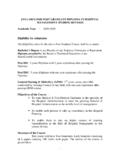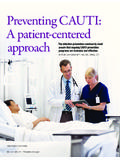Transcription of Communication and Nursing: Historical Roots and Related …
1 1 CHAPTER 1 Communication and nursing : Historical Roots and Related TheoryValerie A. HartPractice helps to impress and retain in the memory the knowledge obtained bytheory, otherwise forgotten without the practical application. Any one who hasbeen ill knows that the height of good nursing consists principally in what isdone for the patient s comfort, outside of the regular orders. A theoretical nurseperforms her duty in a perfunctory manner, and may carry out the doctor sorders to the letter; but the patient recognizes there is something lacking,and we know that it is the skilled touch, the deft handling, the keenness todetect changes and symptoms, the ready tact, the patience, the power of con-trolling her feelings and temper, self-reliance, the kindly sympathy for the sor-rowing, and the peculiar power of soothing suffering which can be acquiredonly by much practice; and a nurse without these attributes, despite her widetheoretic knowledge and teaching, will never be a successful one(Brennan,2006, p.)
2 191).In this chapter, the early Roots and influences of communications and nurs-ing will be explored. In addition to acknowledging the contributions of those con-cerned with the subject of patient Communication , this text primarily utilizestheories Related to patient-centered care, novice to expert development, and re-flective practice. These theories will be explored and will form the foundationfor the focus of Communication practice for the advanced practice nurse. Thetext will build on basic Communication theory and encourage the reader to honetheir skills in this the role and importance of Communication theory and practice innursing requires an amount of speculation and reliance on early nursing curricu-lum. In order to understand the place of Communication theory in nursing prac-tice, we must look to the past and fully explore the early nursing pioneers and thosetheorists who influenced them. It is also important to remember that nursing , formany decades, was attempting to carve out a clear definition of itself, a scope 8/5/09 6:25 PM Page 1 Jones and Bartlett Publishers, LLC.
3 NOT FOR SALE OR DISTRIBUTION. practice in order to take its place as a true profession. Many nursing programstoday give only a brief allotment of time to the subject of nursing history. Whilenursing history, once was a staple in the nursing curriculum as a way to acculturatethe new student, over time has been shed and replaced by other American Association for the History of nursing (AAHN) has developeda position statement regarding the importance of including nursing history in thecurriculum in order to prepare nurses for the 21st century. AAHN recommendsthat nursing history be included in both undergraduate and graduate curriculaand that a separate course in nursing history be part of any doctoral program innursing (AAHN, 2001). By examining the Historical Roots of the concepts ofpatient provider relationships, and what constitutes nursing care, we can clearlyexplore the topic of provider communications with patients and families.
4 With-out the proper backdrop it might seem like a new idea when, in fact, it has beenemphasized by nursing educators and practitioners since the first nurse minis-tered to the first nursing EDUCATIONI nitially, nursing education was based on the apprentice model of educationand was designed to meet the service needs of the hospital with which the schoolwas affiliated (Box 1-1). Although not all schools of nursing were affiliated withhospitals, this was certainly the template developed by Florence Nightingale2 CHAPTER1 Communication ANDNURSING1893, formation of The National League for nursing Education1917, release of the first standard curriculum for schools of nursing1918, Goldmark Report, assessing nursing education1928, Nurses, Patients, and Pocketbookspublished1934, nursing Schools Today and Tomorrowpublished1936, publication of NLNE Essentials of a Good School of nursing (Effie Taylor,president)1937, revision of NLNE s curriculum guideBox 1-1 Early Development of nursing 8/5/09 6:25 PM Page 2 Jones and Bartlett Publishers, LLC.
5 NOT FOR SALE OR DISTRIBUTION. and adopted in the United States. Although there was some variation in earlynursing curricula, it is safe to assume that the emphasis was on practical workand service. A typical example is the 1918 curriculum from the University ofTexas School of nursing , the oldest nursing school in Texas and one of the old-est in the Southwest. Established in 1890 as the John Sealy Hospital TrainingSchool of Nurses, it was originally organized as an independent school under aboard of lay managers. The didactic classroom requirements were as follows(Pope, 1937):First Year:Anatomy and Physiology: 30 hoursFever nursing : 12 hoursTheory of nursing : 12 hoursBacteriology: 14 hoursPreventative Medicine: 14 hoursMateria Medica: 15 hoursSecond Year:Surgical nursing : 14 hoursMedical nursing : 10 hoursGynecological nursing : 15 hoursObstetrical nursing : 15 hoursDiatetics:15 hoursInvalid Cookery: 40 hoursThird Year:Pediatric nursing : 8 hoursEye, Ear, Nose, and Throat: 8 hoursMental and Nervous Disease: 6 hoursTheory of nursing : 20 hoursEthics: 6 hoursMassage: 32 for Three Years: 314 hoursWe cannot know for certain what was included in a lecture on the Theoryof nursing , and it is possible that the topic of patient Communication wassqueezed into the brief time allocated for Mental and Nervous Disease.
6 But itis more likely that very little time was devoted to the topic of patient commu-nication. This early curriculum is a typical example of what followed from the1917 release of the first Standard Curriculum for Schools of nursing , developedby the National League for nursing Education. This organization, formed in1893, during the Chicago World s Fair, was originally the American Society ofEarly nursing 8/5/09 6:25 PM Page 3 Jones and Bartlett Publishers, LLC. NOT FOR SALE OR DISTRIBUTION. Superintendents of Training Schools for Nurses. From its inception, the associ-ation made its principal objective the establishment and maintenance of a uni-versal standard of training. In 1912 the society was renamed the National Leaguefor nursing Education (NLNE).It was not until after World War I and the influenza pandemic had recededthat nursing leaders would take stock of the state of nursing education in theUnited States. In 1918, a 5-year study funded by the Rockefeller Foundationwas initiated and aimed to assess the current condition of nursing educationin the United States.
7 Commonly referred to as the Goldmark Report (a mem-ber of the committee), this study highlighted the many weaknesses of the ap-prentice model of nursing education (Dolan, 1983). The Goldmark Report wascritical of the relationship schools had with hospitals, the quality of faculty andoverall education, and made strong recommendations for change. Unlike theFlexner Report, the equivalent study of medical schools, this report was notmade public and, even if some schools closed as a result, the vast majoritydid not and nothing changed in regard to the model of nursing education. Over-all, the sharp criticism in the Goldmark Report did little to make changes inhow nursing education was delivered, how schools were organized, or what thenursing curriculum looked like. The financial ties that nursing schools had tohospitals were simply too strong and, thus, the incentive to keep doing busi-ness as usual prevailed. Instead of reform, more studies of nursing followed,including Nurses, Patients and Pocketbooks(1928) and nursing Schools Todayand Tomorrow(1934), both instigated by the American Nurses Association(ANA).
8 Again, the findings reported serious shortcomings on the part of fac-ulty preparation as well as the actual educational programs. Perhaps as a wayof addressing these concerns, the NLNE published a specific guide in 1936,Essentials of a Good School of nursing . This guide provided the scaffoldingfor what was essential in nursing and, therefore, nursing curricula. It is in-teresting to note that among the eight guidelines regarding what a professionalnurse should know, number four was:All professional nurses should be able to apply, in nursing situations, thoseprinciples of mental hygiene which make for a better understanding of thepsychological factor in illness(National League for nursing [NLN], 1936).This criterion may be interpreted as an early remnant of what we havecome to understand as nursing diagnosis, or an appreciation of the patients perspective regarding their illness. It can also be seen as acknowledging thepsychosocial aspects of physical illness.
9 Regardless of the interpretation, thecriterion points to the necessity of communicating with patients in order toidentify and incorporate their Communication 8/5/09 6:25 PM Page 4 Jones and Bartlett Publishers, LLC. NOT FOR SALE OR DISTRIBUTION. INFLUENCE OF PSYCHIATRIC MENTAL HEALTH NURSINGIt was in the clinical specialty of psychiatric nursing that the concepts andtheories of Communication and the nurse patient relationship were to be de-veloped and introduced into the entire discipline of nursing . Most schools ofnursing did not offer a separate clinical experience or theory portion focused onpsychiatric mental health until quite late. By 1944 there were still 14 states thathad no psychiatric courses in their nursing programs (Kalisch & Kalisch, 2004).The change to having psychiatric nursing included in nursing curricula is cred-ited to the efforts of Effie Taylor. A graduate of Johns Hopkins School of Nurs-ing in 1904, Taylor later studied at Teachers College, Columbia University, andYale s Department of Public Health.
10 Her career included serving as AssociatePrinciple at Johns Hopkins School of nursing until 1922, Superintendent of theConnecticut Training School (later named Yale University School of nursing ),and second Dean of Yale s School of nursing . It was Taylor s interest in patient-centeredcare that led her to arrive at a different model for nursing . Under herleadership, nurses were assigned to specific patients instead of specific tasks,such as dispensing medications or obtaining vital signs for all patients on a model was clearly the beginning of what was later referred to as primarynursing. The ability to form a relationship with a patient and family over time,even if during a brief hospitalization, promotes continuity of care. The model alsorelieves the nurses from being purely task oriented, and places the patient at thecenter of their work. The patient s emotional and intellectual state was also em-phasized in this model of providing care (Church, 1988; Friedman, 1988).










